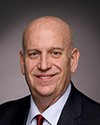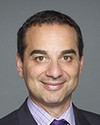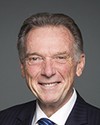If I may, I'll recapitulate a few of my initial points so that they can be interpreted for everyone in the room.
First, I want to emphasize that a Canadian development finance institution needs to be additional to existing official development assistance. It needs to add to the total envelope of financing that Canada provides to developing countries, either in partnership with the private sector or in the form of grants that come from the public sector. Aid and private financing are complements to each other. There are some public goods that can be provided only through public financing. There are other, complementary activities that are germane to public-private partnerships. A Canadian DFI should be an additional source of financing on top of official development assistance, not a substitute for that assistance.
At the same time as we commit to bringing in a Canadian DFI, we should also be concerned with ensuring that Canada's official development assistance is increased toward the long-term goal of 0.7% of GDP. That said, even if every OECD country were to raise official development assistance to Pearson's 0.7% goal, development assistance in that form would not be enough to reach the sustainable development goals. At 0.7%, total ODA flows would be at about $350 billion to $400 billion U.S. per year. Most estimates of what is required to hit the SDGs imply that somewhere between $500 billion and $3 trillion U.S. extra in financing are needed annually between now and the SDG target year of 2030.
Engaging the private sector and catalyzing private capital for development assistance are really not things about which we have a choice. We absolutely must do what we can to ensure that capital begins flowing to the 40 or 50 countries that receive almost no foreign direct investment at the moment outside of their resource sectors. That, to me, is the global case for Canada engaging in public-private partnerships for development.
The rest of my remarks will focus on design considerations for a Canadian development finance institution.
First, you may reasonably ask why Canada needs a DFI. Why has it been under discussion for almost 40 years, yet we haven't followed through on the creation of a DFI? I'll leave the question of why we haven't followed through to those who understand the ways of Ottawa better than I do. The logic of a DFI is inescapable. Every other G7 country has one. Almost every OECD country has one. Put bluntly, by not having a DFI, we are leaving good money on the table for others to benefit from.
Other countries' DFIs have a long history of making profits by doing good. Britain's Commonwealth Development Corporation hasn't drawn on the public purse for over 15 years in its development financing. The United States Overseas Private Investment Corporation, OPIC, estimates that it earns $8 for U.S. taxpayers for every $1 invested in its overhead. In the case of the world's DFI, the International Finance Corporation, which is part of the World Bank, we know that its profits get recycled directly back into expanding its lending portfolio.
A DFI for Canada makes a lot of sense because it provides an opportunity not only to do more, but to actually finance doing good in a way that does not imply further drains on the public purse.
Looking specifically at the design of a Canadian DFI, I want to recapitulate and essentially repeat a few messages from my submission to the pre-budget consultations in which I participated in 2014. The logic and the design considerations for a DFI have not changed in the intervening two and a half years.
First, I am heartened to see that it is being considered as a subsidiary institution under EDC. It is critical that it have an independent-minded and risk-loving board, perhaps more risk-loving than EDC's board, because of the nature of the financing in which it would be engaging: in more difficult circumstances and more challenging countries, and in sectors where the returns may have a much longer horizon than in the areas in which EDC traditionally invests.
On sizing the Canadian DFI, I should say at the outset that the government's inclusion of a $300-million, five-year capitalization in its budget proposal needs further fleshing out. If $300 million is considered the initial capital overhead to set up the offices and the operations of the DFI, then I'm encouraged that we're speaking about the DFI in an appropriate scale and size. But if that's meant to be the lending portfolio over the next five years, then it's woefully inadequate. Of course, in any context about development assistance, you're going to hear people saying we need more. Now, I'm not simply adding a voice to that chorus and saying, “More, more, more.” I'm adding what I think is a very practical point, which is that for $50 million a year, the overhead to do a lot of small projects would not justify the impact of that small-scale lending. The $300 million really ought to be the basis to get this institution going and provide the underlying overhead or framework by which this institution goes out and catalyzes substantial additional financing.
To give you a sense of the scale we're talking about, the six existing G7 DFIs provide annual commitments equivalent to about 3.3% of their countries' private capital flows to developing countries, or about 0.024% of their national GDPs. Translated into Canadian terms, that implies an annual lending portfolio somewhere between $350 million and $500 million Canadian. That looks at an annual commitment that is larger than the five-year commitment that has been articulated in the budget.
My deep concern is that at $300 million over five years, we don't have enough committed to even launch what is going to be a successful pilot or proof of concept. We need to look at a much greater scale. The way to do so, I believe, is to ensure that the DFI's lending portfolio is financed largely out of capital-raising through private markets, that is, through the issuance of debt or bonds, or private placements in international capital markets, much as EDC does right now, though likely at a much longer maturity and with perhaps contingent payback valuations or provisions to reflect the impact aspect of the financing the DFI is providing.
The DFI could also be involved in issuing debt into local and developing capital markets that don't currently have established benchmark yield curves, much as the World Bank did in places such as South Africa and Greece in the nineties. That provided a benchmark by which public institutions could then also go into capital markets, and private companies could also raise debt.
The DFI should also be empowered to retain the profits that it makes from its lending operations. We may not see returns for several years, but if we are to grow the institution, much as its corollary institutions in other G7 countries have done, those profits should be largely recycled back into, first, paying off the initial capital commitment from the Canadian government, and then expanding its existing portfolio. This is what happens with other G7 DFIs. Other G7 DFIs, such as KfW in Germany, issue debt in the way that I'm proposing. I believe this is the way to ensure that we have an institution that operates on the scale that's needed to have true impact and to ensure the ratio of overhead to returns is appropriate.
Thirdly, I want to focus on what activities a Canadian DFI should engage in. Looking at 30 or 40 years of activities of other DFIs, we see that a few salient findings have come to the fore, two of which are really critical here.
One is that unless the development, impact, and financial imperatives of the DFI are written firmly into its governance from the outset, into the DNA of its board and into the incentives provided for its staff, the development impact will always play second fiddle to the financial imperative. We need to ensure that the entire institution is built to balance those two imperatives.
Second, a Canadian DFI needs to be substantially more risk loving than other DFIs. One of the consistent findings of review of existing DFIs is that they tend to invest in sectors that are already receiving foreign investment: the fifth cellphone provider in Ghana, the 12th luxury hotel in Nairobi. This is not the way to have impact nor to justify the expense and the effort of creating a Canadian DFI, which needs to be focused on higher-risk lending in places where no other investors will go.
To do so effectively, it needs a full range of financial instruments, everything from loans to the ability to take equity shares, provide guarantees, and provide risk insurance. The multilateral provider of risk insurance, MIGA, under the World Bank Group has shown in its annual reports that it has a very small payout rate on its insurance policies.
In one way that would be an indication that it's writing incredibly good policies. I take it as an indicator that it's not providing insurance in the places that truly need it, where there is truly great risk. That leaves open a huge swath of the developing world where a Canadian DFI could provide guarantees for insurance that draw very little on its balance sheet or its portfolio, yet at the same, have great impact.
A Canadian DFI, unlike some others, should also be unconstrained by nationality. It should be able to work with the best investors, the best projects, and the best ideas, regardless of which passports they hold, be they Canadians, members of the Canadian diaspora, or foreign companies.
The Overseas Private Investment Corporation in the United States has found its hands substantially bound by a requirement to only work with U.S. companies. It has found ways to get around that by declaring a U.S. company to be anyone that has a substantial degree of activity on American soil. But why create an institution that needs to engage in such gymnastics to do good work? Let's be as open as Canada is in every other way to good ideas, good people, and good capital in constructing the DFI to work with anyone who meets its standards.
As I mentioned earlier, our DFI should be focused on the regions and sectors that are not receiving financing in a substantial way. It should always be judged by not only whether it is meeting its development and its fiduciary impacts but whether it is also going where other institutions will not go.
Lastly, and this may sound like a small point—even a pedantic one—in talking about nomenclature, but in the discussion of this project three different terms have been used between the previous federal government and the current one in describing it. The 2015 budget referred to a development finance initiative. The 2017 budget referred to a development finance institution. The May 5 announcement that the institution or initiative would be located in Montreal, referred to it as an institute. Those three words in this space define very different things.
An institute is denoting something like a research body or think tank. We don't need another research body or think tank in this space. Other organizations and countries have already developed a huge body of best practice that we can implement. We know where the gaps are. We know which countries and sectors are not getting financing. We know which ideas are not able to move from conceptualization to implementation. We don't need another institute.
An initiative, under the 2015 budget, bespoke something with small ambitions. There is no reason for Canada to play small in this space. We should be leveraging our strengths and doing something truly impactful.
As the 2017 budget said, I think this should be a development finance institution. We should see it as a thriving subsidiary to EDC with an independent, risk-loving board able to invest in areas that are not receiving support at the moment, leverage good ideas, and complement what I hope is an expanding envelope of official development assistance, and it should be able to receive support from all members of the House in going forward.
Thank you. I look forward to your questions.









